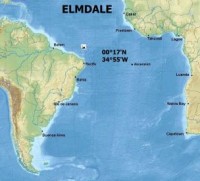- D E F
17)DUQUESA (CAPT BY RAIDER SCHEER)
.jpg)

Both maps above show the position where SS Duquesa was captured and the aproximate position where she was sunk on 28 Feb. 1941

Photo. www.wrecksite.eu

Built 1918
Tonnage: 8,651 / 9,540 tons
Cargo. 14.5 million Eggs and 3,000 tons of meat on board.
Captured 18 DEC 40 by Adm Scheer on pos 00º 57’N 22º 42’W. Scuttled 28 February 1941
0 Dead
99 POW
On about 17th February, 1941, they met the S.S. "Duquesa," then in German hands, in estimated position 20° S. and 017° W. "Duquesa" had been captured by the pocket battleship "Admiral Scheer" on 18th December, 1940. The ship was found to be loaded with eggs for the Argentine, and it was decided to put a prize crew of "Admiral Scheer" men aboard and to use the vessel as a stationary supply ship for any raider, or other German ship, which could rendezvous with her.
Prisoners from "33" stated that they believe that raiders "10," "16" and possibly "41" all visited "Duquesa" to take off eggs, besides German supply ships. The "Admiral Scheer" is also believed to have visited "Duquesa" to take off eggs, besides German supply ships. The "Admiral Scheer" is also believed to have revisited "Duquesa" on at least one occasion.
At the time of the rendezvous with "33," "Duquesa," a coal burner, had exhausted her fuel and all woodwork about the ship had been chopped up and consumed. The meat carried by "Duquesa" had also gone bad, owing to lack of fuel for the refrigerating plant, and it was decided that the best plan was to sink the ship. While preparations were being made "Duquesa's" prize crew broke open the remaining eggs and stated a battle royal, each man being armed with a quantity of eggs as ammunition.
This battle came to an abrupt end when two men fell down a hold and suffered broken limbs and other injuries. The prize crew was then taken off and distributed among the Norwegian whalers to release a number of ratings from "33" for further duties in their own ship.


In detail above one of the several boxes containing 14,500,000 eggs
While "33's" men were making arrangements to sink "Duquesa," a second accident occurred. It had been planned to dynamite a number of bulkheads inside the ship, in order to hasten sinking when the final scuttling charge was fired. One of these preliminary explosions proved far greater than anticipated, owing it was thought, to the fact that the air was thick with coal dust, and two ratings were severely burned. Prisoners stated that the scuttling charge was then fired electrically from a motor boat.



